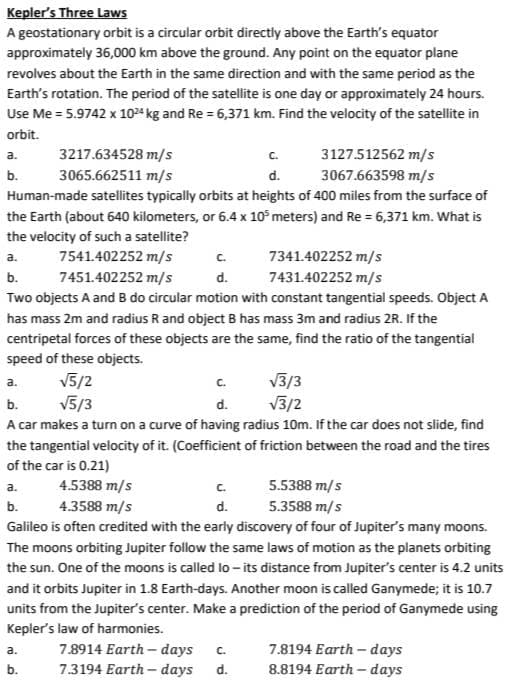Kepler's Three Laws A geostationary orbit is a circular orbit directly above the Earth's equator approximately 36,000 km above the ground. Any point on the equator plane revolves about the Earth in the same direction and with the same period as the Earth's rotation. The period of the satellite is one day or approximately 24 hours. Use Me = 5.9742 x 1024 kg and Re = 6,371 km. Find the velocity of the satellite in orbit. C. 3127.512562 m/s 3067.663598 m/s d. Human-made satellites typically orbits at heights of 400 miles from the surface of the Earth (about 640 kilometers, or 6.4 x 105 meters) and Re = 6,371 km. What is the velocity of such a satellite? 7541.402252 m/s 7451.402252 m/s Two objects A and B do circular motion with constant tangential speeds. Object A has mass 2m and radius R and object B has mass 3m and radius 2R. If the centripetal forces of these objects are the same, find the ratio of the tangential speed of these objects. √5/2 C. b. √5/3 d. A car makes a turn on a curve of having radius 10m. If the car does not slide, find a. b. a. b. a. 3217.634528 m/s 3065.662511 m/s C. d. 7341.402252 m/s 7431.402252 m/s √3/3 √3/2
Kepler's Three Laws A geostationary orbit is a circular orbit directly above the Earth's equator approximately 36,000 km above the ground. Any point on the equator plane revolves about the Earth in the same direction and with the same period as the Earth's rotation. The period of the satellite is one day or approximately 24 hours. Use Me = 5.9742 x 1024 kg and Re = 6,371 km. Find the velocity of the satellite in orbit. C. 3127.512562 m/s 3067.663598 m/s d. Human-made satellites typically orbits at heights of 400 miles from the surface of the Earth (about 640 kilometers, or 6.4 x 105 meters) and Re = 6,371 km. What is the velocity of such a satellite? 7541.402252 m/s 7451.402252 m/s Two objects A and B do circular motion with constant tangential speeds. Object A has mass 2m and radius R and object B has mass 3m and radius 2R. If the centripetal forces of these objects are the same, find the ratio of the tangential speed of these objects. √5/2 C. b. √5/3 d. A car makes a turn on a curve of having radius 10m. If the car does not slide, find a. b. a. b. a. 3217.634528 m/s 3065.662511 m/s C. d. 7341.402252 m/s 7431.402252 m/s √3/3 √3/2
Physics for Scientists and Engineers: Foundations and Connections
1st Edition
ISBN:9781133939146
Author:Katz, Debora M.
Publisher:Katz, Debora M.
Chapter7: Gravity
Section: Chapter Questions
Problem 7PQ: Model the Moons orbit around the Earth as an ellipse with the Earth at one focus. The Moons farthest...
Related questions
Question

Transcribed Image Text:Kepler's Three Laws
A geostationary orbit is a circular orbit directly above the Earth's equator
approximately 36,000 km above the ground. Any point on the equator plane
revolves about the Earth in the same direction and with the same period as the
Earth's rotation. The period of the satellite is one day or approximately 24 hours.
Use Me = 5.9742 x 1024 kg and Re = 6,371 km. Find the velocity of the satellite in
orbit.
C.
3127.512562 m/s
3067.663598 m/s
d.
Human-made satellites typically orbits at heights of 400 miles from the surface of
the Earth (about 640 kilometers, or 6.4 x 10³ meters) and Re = 6,371 km. What is
the velocity of such a satellite?
a.
7541.402252 m/s
7451.402252 m/s
a.
b.
3217.634528 m/s
3065.662511 m/s
C.
d.
a.
b.
b.
Two objects A and B do circular motion with constant tangential speeds. Object A
has mass 2m and radius R and object B has mass 3m and radius 2R. If the
centripetal forces of these objects are the same, find the ratio of the tangential
speed of these objects.
a.
√5/2
√3/3
b.
√5/3
d.
√3/2
A car makes a turn on a curve of having radius 10m. If the car does not slide, find
the tangential velocity of it. (Coefficient of friction between the road and the tires
of the car is 0.21)
a.
4.5388 m/s
5.5388 m/s
b.
4.3588 m/s
5.3588 m/s
Galileo is often credited with the early discovery of four of Jupiter's many moons.
The moons orbiting Jupiter follow the same laws of motion as the planets orbiting
the sun. One of the moons is called lo- its distance from Jupiter's center is 4.2 units
and it orbits Jupiter in 1.8 Earth-days. Another moon is called Ganymede; it is 10.7
units from the Jupiter's center. Make a prediction of the period of Ganymede using
Kepler's law of harmonies.
7341.402252 m/s
7431.402252 m/s
C.
d.
7.8914 Earth-days C.
7.3194 Earth-days d.
7.8194 Earth-days
8.8194 Earth-days
Expert Solution
This question has been solved!
Explore an expertly crafted, step-by-step solution for a thorough understanding of key concepts.
Step by step
Solved in 5 steps with 5 images

Knowledge Booster
Learn more about
Need a deep-dive on the concept behind this application? Look no further. Learn more about this topic, physics and related others by exploring similar questions and additional content below.Recommended textbooks for you

Physics for Scientists and Engineers: Foundations…
Physics
ISBN:
9781133939146
Author:
Katz, Debora M.
Publisher:
Cengage Learning

University Physics Volume 1
Physics
ISBN:
9781938168277
Author:
William Moebs, Samuel J. Ling, Jeff Sanny
Publisher:
OpenStax - Rice University

Principles of Physics: A Calculus-Based Text
Physics
ISBN:
9781133104261
Author:
Raymond A. Serway, John W. Jewett
Publisher:
Cengage Learning

Physics for Scientists and Engineers: Foundations…
Physics
ISBN:
9781133939146
Author:
Katz, Debora M.
Publisher:
Cengage Learning

University Physics Volume 1
Physics
ISBN:
9781938168277
Author:
William Moebs, Samuel J. Ling, Jeff Sanny
Publisher:
OpenStax - Rice University

Principles of Physics: A Calculus-Based Text
Physics
ISBN:
9781133104261
Author:
Raymond A. Serway, John W. Jewett
Publisher:
Cengage Learning

Classical Dynamics of Particles and Systems
Physics
ISBN:
9780534408961
Author:
Stephen T. Thornton, Jerry B. Marion
Publisher:
Cengage Learning